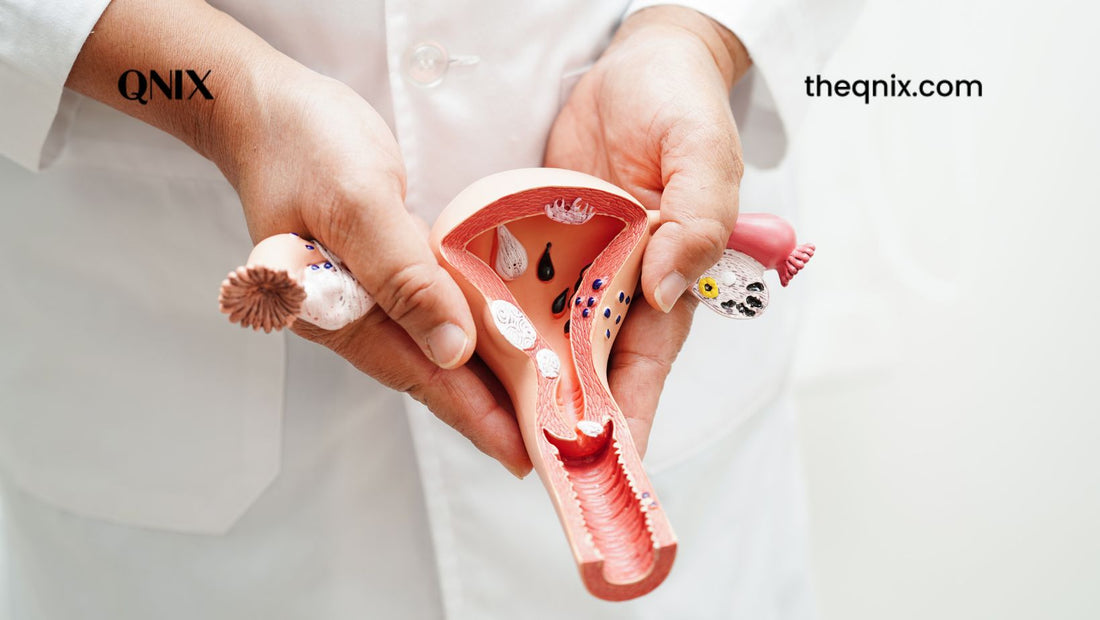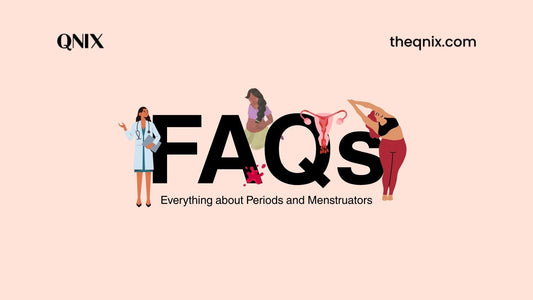Have you ever wondered if your period could somehow flow backward?
It's a curious thought, often brought up in conversations about period health. This phenomenon, known as retrograde menstruation, might sound strange, even a little scary, but it's more common than you might think.
Aren’t periods enough of a nuisance in itself that now it has to flow in the wrong direction?
In this article, we’ll explore what retrograde menstruation is, how it relates to your menstrual cycle, and what it means for your health.
Table of contents
- Demystifying the Menstrual Cycle
- Understanding Retrograde Menstruation
- Retrograde Menstruation and Endometriosis
- When to Talk to Your Doctor
- Living with Retrograde Menstruation
- FAQs
Demystifying the Menstrual Cycle
First, let’s have a quick recap of what menstruation is.
Every month, the lining of your uterus (endometrium) thickens to prepare for a possible pregnancy. If no pregnancy occurs, this lining sheds and exits your body through the cervix and vagina, which is what we know as a period.
Also Read: Dark Chocolate for Period Cramps: The Top 5 Picks
Breakdown of the Menstrual Cycle
The menstrual cycle is a natural process that prepares the body for potential pregnancy each month. It can be divided into four phases:
- Follicular Phase: This phase begins on the first day of your period and continues until ovulation. During this time, the hormone estrogen causes the uterine lining to thicken.
- Ovulatory Phase: Around the middle of the cycle, an egg is released from the ovary.
- Luteal Phase: After ovulation, the hormone progesterone helps prepare the uterine lining for a potential pregnancy.
- Menses Phase: If the egg is not fertilized, the uterine lining is shed, resulting in menstrual bleeding.
What is the Uterine Lining?
The uterine lining, also known as the endometrium, is the inner layer of the uterus. It plays a crucial role in the menstrual cycle and in pregnancy.
Each month, the endometrium thickens in response to hormonal signals. This thickening is necessary to create a nutrient-rich environment where a fertilized egg can implant and develop.
If fertilization does not occur, the endometrium is shed during menstruation. This shedding results in menstrual bleeding, commonly known as a period.
The process involves the breakdown and expulsion of the lining through the cervix and vagina.
Hormonal Regulation
Estrogen and progesterone are the primary hormones that orchestrate the cycle's phases. They control the growth and shedding of the endometrium, ensuring the cycle progresses smoothly.
- During the follicular phase, estrogen promotes the thickening of the uterine lining, preparing it for potential pregnancy.
- Ovulation is triggered by releasing an egg from the ovary. In the luteal phase, progesterone stabilizes the endometrium, readying it for implantation.
- If fertilization does not occur, hormone levels drop, leading to the shedding of the uterine lining during menstruation.
This cyclical hormone interplay ensures the regularity and health of menstrual periods.
Also Read: Stop Heavy Periods Naturally: 7 Proven Tips and Remedies
Understanding Retrograde Menstruation
Retrograde menstruation is a condition where menstrual blood flows backwards through the fallopian tubes and into the pelvic cavity instead of leaving the body through the cervix and vagina.
This phenomenon is thought to be relatively common and occurs in varying degrees in many women during their menstrual cycles.
Potential causes of retrograde menstruation
Several factors might contribute to retrograde menstruation, such as:
- Anatomical Variations: Certain physical characteristics might predispose some individuals to retrograde flow.
- Strong Uterine Contractions: More forceful contractions during menstruation can push blood backward into the fallopian tubes.
Where does the Retrograde Menstrual blood go?
The back flowing blood may end up in the pelvic cavity, where it can come into contact with various organs. Most of the time, the body reabsorbs this blood without any issues.
Retrograde menstruation is more common than once thought and doesn’t necessarily indicate a problem. It’s a natural variation in menstrual blood flow that many experience without any symptoms.
Also Read: Naturally Delay Your Period: 13 Ways to Postpone Menstruation
Are there any symptoms of retrograde menstruation?
Asymptomatic Nature
Most people with retrograde menstruation experience no symptoms at all.
This means that for many, the backward flow of menstrual blood through the fallopian tubes into the pelvic cavity does not cause any noticeable issues or discomfort.
Potential Symptoms
In some cases, retrograde menstruation may lead to symptoms such as:
- Pelvic Pain: Some might experience discomfort or pain in the pelvic area.
- Cramping: Similar to typical menstrual cramps but potentially more intense.
- Heavier Periods: An increase in menstrual flow might be observed.
Importance of Individual Experience
It’s important to understand that symptom severity and experience can vary significantly from person to person. While one individual may have mild or no symptoms, another may experience more pronounced discomfort.
This variability underscores the importance of paying attention to your own body and seeking medical advice if you notice any unusual or severe symptoms.
Retrograde Menstruation vs Endometriosis
Retrograde menstruation is often discussed in the context of endometriosis, a condition where tissue similar to the lining of the uterus grows outside it.
One theory suggests that back flowing menstrual blood can lead to the implantation of endometrial tissue outside the uterus, potentially causing endometriosis.
However, it’s crucial to note that retrograde menstruation alone doesn’t cause endometriosis. Other factors, such as immune system responses and genetic predispositions, also play significant roles.
If you experience symptoms like severe pelvic pain or abnormal bleeding, it’s essential to consult a doctor for a proper diagnosis and treatment plan.
When to Talk to Your Doctor
It's important to seek medical advice if you experience any of the following:
- Severe Pelvic Pain: If you have intense, chronic, or debilitating pelvic pain that interferes with your daily activities, it's essential to consult a healthcare provider.
- Abnormal Bleeding Patterns: This includes very heavy bleeding (menorrhagia), bleeding between periods, prolonged periods, or irregular menstrual cycles.
- Fertility Concerns: If you have been trying to conceive for a year or more without success, or if you suspect conditions like endometriosis that could impact fertility, seek medical guidance.
Also Read: UTI and Menstrual Delays: Debunking the Myths and Understanding the Facts
Importance of an Early Diagnosis
Early diagnosis and treatment of any underlying conditions can significantly improve outcomes. For example, early intervention in cases of endometriosis can help manage symptoms better and prevent complications like infertility.
Diagnosing hormonal imbalances early can also prevent long-term health issues.
Open Communication
Maintaining open communication with your doctor about your menstrual health is vital. Don't hesitate to discuss any concerns, symptoms, or irregularities you experience. This dialogue helps ensure you receive the appropriate care and support tailored to your specific needs.
Remember, your doctor is there to help you manage your health, so any question or concern is valid and important.
Living with Retrograde Menstruation
General Management Tips
Managing retrograde menstruation can be challenging due to its unpredictable nature. Here are some practical tips to help you navigate through this condition:
- Pain Medication: Consult your doctor about appropriate pain relief options. Over-the-counter nonsteroidal anti-inflammatory drugs (NSAIDs) can help alleviate cramps and discomfort.
- Heat Therapy: Applying a heating pad or hot water bottle to your lower abdomen can provide relief from menstrual cramps. The warmth helps relax the muscles and improve blood flow, reducing pain.
Dietary and Lifestyle Considerations
Making certain dietary and lifestyle changes can also help manage symptoms:
- Dietary Adjustments: Incorporating anti-inflammatory foods such as fruits, vegetables, whole grains, and omega-3 fatty acids (found in fish and flaxseeds) may help reduce menstrual pain.
Avoiding caffeine and high-sugar foods can also be beneficial.
- Lifestyle Changes: Regular physical activity, such as walking, swimming, or yoga, can help improve overall menstrual health. Maintaining a healthy weight and reducing alcohol intake are also important considerations.
It's advisable to discuss these changes with a doctor or registered dietitian.
Stress Management
Stress can have a significant impact on menstrual health, increasing symptoms. Here are some techniques to manage stress:
- Yoga and Meditation: Practices like yoga and meditation can help reduce stress and promote relaxation. These techniques encourage mindfulness and deep breathing, which can reduce tension and improve your overall well-being.
- Mindfulness and Relaxation: Activities such as deep breathing exercises, progressive muscle relaxation, and spending time in nature can help manage stress effectively.
Qnix Period Underwear: Your Period Comfort Partner
Can managing unpredictable periods associated with retrograde menstruation be made easier?
Yes! Why not?
Qnix period underwear is an innovative solution that offers comfort and leakproof protection, giving you peace of mind during your menstrual cycle.
Benefits of Period Underwear
- Leakproof Technology: Qnix period underwear is designed with advanced leakproof technology to prevent any unwanted leaks, ensuring you stay dry and comfortable throughout the day.
- Comfort and Discreetness: Made from soft, breathable materials, Qnix period underwear provides exceptional comfort and remains discreet under clothing, allowing you to go about your day with confidence.
- Variety and Absorbency Levels: Available in different styles and absorbency levels, Qnix period underwear caters to your specific needs, whether you have light, medium, or heavy flow days.
Qnix period underwear offers a reliable solution for managing unpredictable periods, ensuring comfort and confidence throughout the menstrual cycle.
Explore your options and find the perfect period comfort partner with Qnix today.
Also Read: Spotting in Periods: Understanding Causes, Symptoms, and Remedies
Retrograde Menstruation FAQ
1. What is retrograde menstruation?
Retrograde menstruation occurs when menstrual blood flows backwards through the fallopian tubes and into the pelvic cavity instead of exiting the body through the cervix and vagina. This backward flow can cause the blood to settle on pelvic organs, but it is often asymptomatic.
2. Does retrograde menstruation cause any symptoms?
Most women with retrograde menstruation do not experience any symptoms. However, some might have pelvic pain, cramping, or heavier periods. The severity and presence of symptoms can vary greatly from person to person.
3. Is retrograde menstruation linked to endometriosis?
Retrograde menstruation is one theory for the development of endometriosis, a condition where tissue similar to the lining of the uterus grows outside the uterus. While not all women with retrograde menstruation develop endometriosis, the backward flow of menstrual blood could potentially contribute to the implantation of endometrial cells in the pelvic cavity.
4. Should I be worried if I have retrograde menstruation?
Retrograde menstruation is a common phenomenon and usually does not cause concern. However, if you experience severe pelvic pain, abnormal bleeding patterns, or fertility issues, it is advisable to seek medical advice. Early diagnosis and treatment of any underlying conditions can be beneficial.
5. How can I manage unpredictable periods associated with retrograde menstruation?
Managing unpredictable periods can involve several approaches:
- Pain Medication: Over-the-counter pain relievers can help manage cramps and pelvic pain. Always consult your doctor before starting any medication.
- Heat Therapy: Applying a heating pad or hot water bottle to the pelvic area can alleviate discomfort.
- Dietary Adjustments: A balanced diet and staying hydrated can help manage symptoms. Some women find relief by reducing caffeine and increasing their intake of anti-inflammatory foods.
- Lifestyle Changes: Regular exercise, stress reduction techniques like yoga and meditation, and adequate sleep can improve overall menstrual health.
- Period Products: Using reliable period products such as Qnix Period Underwear can provide comfort and leak protection during unpredictable periods. These products are designed to offer support and ease throughout the menstrual cycle.
For more detailed guidance, it is recommended to discuss your symptoms and management strategies with a healthcare professional.
When should I see a doctor about retrograde menstruation?
You should see a doctor if you experience any of the following symptoms:
- Severe Pelvic Pain: Intense or chronic pelvic pain that disrupts your daily activities or quality of life.
- Abnormal Bleeding Patterns: Very heavy periods, irregular menstrual cycles, or bleeding between periods.
- Fertility Concerns: Difficulty conceiving or having unexplained infertility issues.
- Other Worrying Symptoms: Any additional symptoms that seem unusual or concerning, such as extreme fatigue, severe cramps, or gastrointestinal issues.
Early diagnosis and treatment of any underlying conditions, such is crucial. Proper management can prevent complications and improve your overall health and quality of life.




